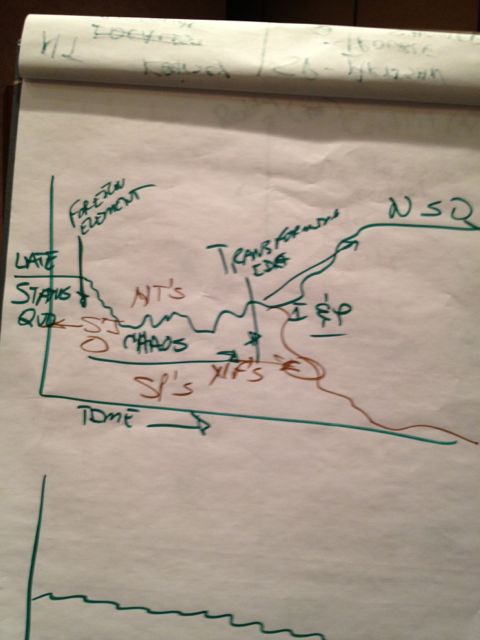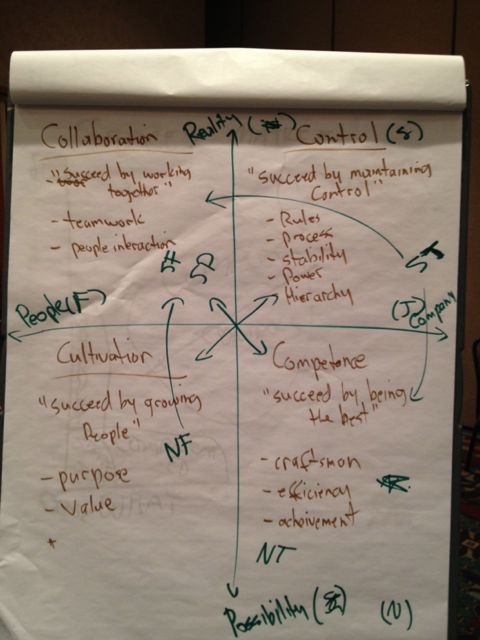A few weeks ago I posted about the relationship between organizational culture types defined by William Schneider in ‘The Re-Engineering Alternative” and MBTI types and temperaments. My theory is that as a change artist, whether it be an external or internal coach, can you increase the odds of creating a successful change by understanding these factors:
- organizational culture type
- type and temperament of the influential people or ‘change sponsor’
- flow of power throughout the organization
I am still learning about this and refining that theory. Here’s a quick example, suppose you, as a change artist, are brought in to transform an organization to Agile. Suppose this organization is a control culture (likes rules, process, stability, hierarchy and power) and the change sponsor (VP or Director or whoever brought in Agile, let’s call him Rick) has MBTI preferences that lend themselves to align with the attributes of a control culture.
Rick may be more likely to see ‘Agile’ as a set of processes and practices over a set of values and principles. As a change artist, an Agile Adoption approach may make more sense. ‘Adoption’ and ‘Transformation’, IMO, are different. Transformation is transforming an organization’s culture to build a learning culture or Agile mindset. Adoption is adopting Agile practices and processes for perceived benefits that are (or at least seem) concrete.
As a change artist providing a less ‘fluffy’ and values/principles approach in favour of a more pragmatic approach of a list of processes and practices with benefits, possible outcomes and an implementation plan increase the odds of a successful change.
Today at AYE we had a small open space session and talked about MBTI and temperaments, how each temperament (SP, NT, SJ, NF) are affected by change using the Virginia Satir change model and how those temperaments may naturally fit into the different organizational cultures. Susan Davis brought up using MBTI function pairings instead. (ST, SF, NT, NF).
First we talked about temperaments:
NT: Rationals, Visionaries – use logic to make decisions, have grand visions of what’s possible
SP: Artisans, trouble-shooters – like to solve problems as quick as possible to find the next problem to solve
NF: Idealist, catalyst – want to make sure everyone in the group is ok and feels included
SJ: Guardian, organizers, stabilizers – like rules and plans, certainty
Of course these are paraphrased, there is a great wealth of information about types and temperaments, these descriptions will suit the purpose of this post.
Next we related temperaments to the Virginia Satir change model.
NT: see the vision of the change and want to progress quickly through chaos.
SP: want to move through chaos as quickly as possible to get to the next problem and adapt quickly
NF: want to make sure everybody is ok while they move through chaos and want to get to the transforming idea so people will be ok.
SJ: may question the need to change and move back to the status quo
Each person will move through the change model at different rates and intensities.
Next we looked at Organizational Culture Types:
Control: rules, process, certainty, power, hierarchy. “we succeed by establishing and maintaining control”
Collaboration: teamwork, synergy, interaction. “we succeed by working together”
Cultivation: purpose/faith, creativity, let things evolve. “We succeed by growing people who fulfil our vision”
Competence: efficiency, craftsmanship, expertise. “We succeed by being the best”
For a fantastic description of culture types, check out Michael Sahota’s post here.
Next we talked about how some temperaments may have a more natural fit in certain cultures. For example, NF’s may fit more naturally in a Cultivation Culture which emphasizes people and possibilities. This culture is in direct conflict with a Control Culture and people who relate more to Control Cultures may have a hard time adjusting to a Cultivation Culture or they may not adapt at all.
What clicked for me was when Susan Davis brought up mapping MBTI function pairings with organizational culture types. Quick side note on MBTI, my type is ISTP:
E/I: Introvert/Extrovert (Energy – Attitude)
N/S: Intuiting/Sensing (Data – Function)
T/F: Thinking/Feeling (Decision – Function)
J/P: Judging/Perceiving (Action – Attitude)
My temperament is SP (Artisan). My function pairing is ST. I am a 50/50 split on N vs S so my temperament aligns well with the NT temperament. I like solving problems, I like inflicting help, I like stuff that is awesome and in the end, it’ll all work out, whatever it is! You can read more on function pairing here.
I will make a better diagram, here’s what we drew up. On the Y axis of the organization culture type, “Reality Focus” for organizations aligns well with people with “S (sensing)” function while the “Possibility Focus” aligns well with “N (Intuiting)” function. On the X-axis, “People Focus” aligns with “F (Feeling)” while “Company Focus” aligns with “T (Thinking)”.
I’m sure that sounds confusing. Here’s what clicked, which is my theory. If you as a change artist understand the culture of the organization and the teams (organizations will have sub-cultures on different teams, departments, social circles etc) and the MBTI preferences of the change sponsor and people in the organization, you may be able to come up with an Agile Adoption or Transformation plan that as a higher chance for success.
The reason I theorize that is solely based on experiences I’ve had and the theory of culture types and MBTI temperaments. In a control organization where the change sponsor has an ST function paring (SJ for example), selling him/her “Agile” as a set of values and principles and creating a learning culture or Agile mindset might not be as effective as selling “Agile” as a set of processes and practices with tangible benefits.
These pieces started coming together during Don Gray’s ‘Reading the River: Understanding Organizational Currents to Get You Where You Want to Go‘ session. It helped me understand how to find leverage points and how to ‘speak the language’ of change in the right way to the right people. If you have a deeper understanding of organizational currents, you can use the knowledge of that organizations culture and people to help take you through the change more effectively than swimming against the current by using “Agile Transformation” approaches when an “Agile Adoption” approach may be a better choice.
To wrap up, no culture is ‘better’ than another, same for type and temperament. Agile-ists will often say “once size Agile doesn’t fit all” and I believe the combination of organizational currents, organizational culture and type/temperament of the influential people in the organization are the keys to figuring out how to work through a change more effectively.

